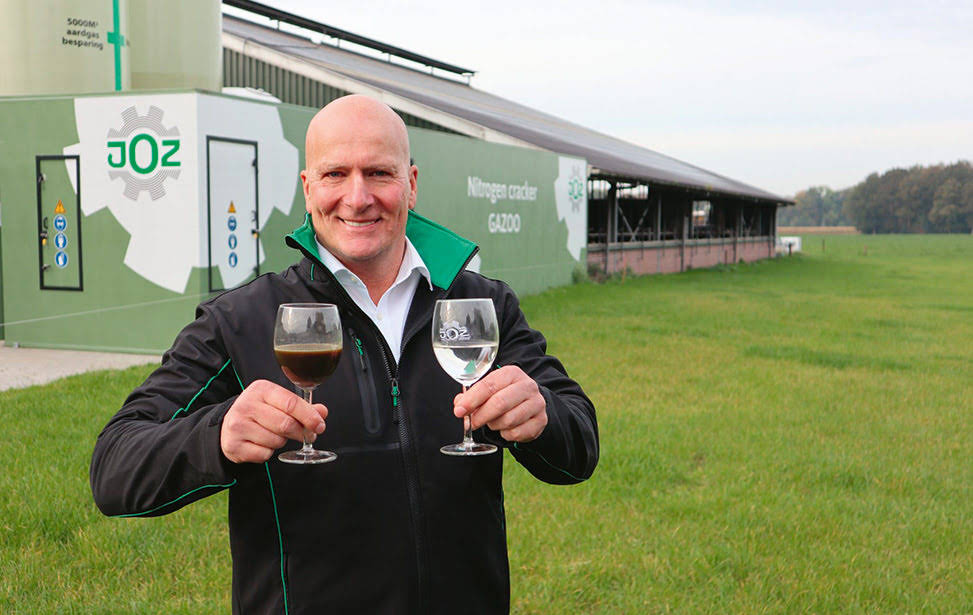- English

On the picture: CEO Arend Kuperus infront of the GAZOO, with a glass of thin fraction in one hand and the fertiliser (Biogrow) in the other.
Although 2021 was an eventful year for JOZ, it was also very fruitful. ‘COVID-19 completely changed our systems and communication,’ says Arend Kuperus, CEO of JOZ. ‘However, we have since expanded our production capacity considerably and launched some wonderful solutions, such as the Gazoo nitrogen cracker. A fantastic highlight.’ Will JOZ continue to evolve positively, and what will it set its sights on in 2022? Arend looks back, and talks about his vision for the future.
Nitrogen cracker
Following the launch of the Gazoo nitrogen cracker in 2020, JOZ installed the first of these systems on a farm in 2021. Gazoo enables farmers to reduce nitrogen emissions and make their own fertiliser at the same time. ‘In 2022, we will be expanding the Gazoo widely,’ says Arend. ‘We’re experiencing enormous demand for the system from the Netherlands, but also from countries such as Germany, Switzerland, France, and Canada.’ ‘’The nitrogen problem has also become more serious than expected in these countries, and the Gazoo is the solution. For this innovation, we looked closely at the whole process, and turned a problem for farmers into an asset. Normally the nitrogen evaporates, but our Gazoo creates a useful product for farmers.’
Rapid return on investment in innovation
JOZ is both an innovative and extremely market-orientated company. ‘That means that we’re constantly looking at events in the market, and listening to our end users,’ Arend explains. ‘This has resulted in the Gazoo being not only an amazing technical solution, but also an extremely practical solution for livestock farmers. As a bonus, farmers can quickly earn back the investment in innovation. In this way, we increase efficiency.’ ‘We at JOZ would like to contribute to solving this social problem, and our solution is the Gazoo. The development of this innovation reflects the innovative nature of the Dutch agricultural sector, and how it can systematically solve its problems by itself..’
The Netherlands: champions in innovation
‘’We’re the real champions of innovation in the Netherlands when it comes to innovation in the livestock sector,’ according to Arend. ‘Other countries are calling in help from Dutch specialists for good reason. The Netherlands is a shining example for countries such as France and Germany. Even in America, almost all the robots are European. It makes it all the more unfortunate that politicians pay such little attention to this. Politicians want to buy out farmers, but that only drives them abroad and leaves the Netherlands a poorer place. That’s not a solution.’
New developments and solutions
So, how do we solve the problem? ‘By innovating,’ says Arend. ‘And for a company to innovate, it must continually evolve. At JOZ, we’re working on a range of really interesting projects, and we’ll certainly be launching some new solutions in 2022. For example, we’re working on an automatic spreader. This innovation automatically scatters the solid fraction of the manure, so it can be used as biobedding. Another great product with which we can relieve farmers of some routine work.’
JOZ is also developing various types of sensors to enrich products. ‘Soon, we’ll be installing these sensors, for example on our manure robots, which are already working in the barn 24 hours a day,’ explains Arend. ‘These sensors enable us to collect all kinds of information that can benefit the livestock farmer, such as insight into conditions in the barn, the ammonia level, the humidity, and so on.’
‘This kind of information is becoming increasingly important for farms, given the ever stricter regulations. Sensors help build up a database which can be used to provide evidence. That makes the life of a livestock farmer so much easier.’
Shouldering the burden for farmers
JOZ is therefore continually evolving. Arend: ‘We look at both the market and the end user. It’s something we’ve been doing for 75 years, and hope to carry on doing for at least another 75. We want to be the market leader on both sides of the feed fence, by making sure our products perfectly match farmers’ needs, by shouldering the burden for farmers, and by making processes more efficient. By doing this, we ensure that farms change and evolve, and that we remain champions in the Netherlands’.